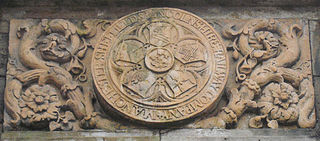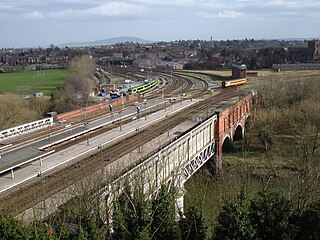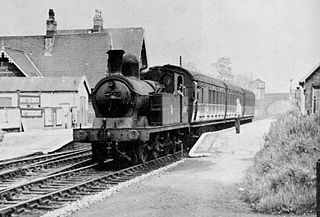
The London and North Western Railway was a British railway company between 1846 and 1922. In the late 19th century, the L&NWR was the largest joint stock company in the United Kingdom.

Crewe railway station is a railway station in Crewe, Cheshire, England. It opened in 1837 and is one of the most historically significant railway stations in the world.

The Manchester, Sheffield and Lincolnshire Railway (MS&LR) was formed in 1847 when the Sheffield, Ashton-under-Lyne and Manchester Railway joined with authorised but unbuilt railway companies, forming a proposed network from Manchester to Grimsby. It pursued a policy of expanding its area of influence, especially in reaching west to Liverpool, which it ultimately did through the medium of the Cheshire Lines Committee network in joint partnership with the Great Northern Railway and the Midland Railway.

The Buckley Railway was opened from Buckley to a connection with the Chester to Holyhead main line on 7 June 1862, to convey coal and finished brickworks products from the Buckley area. Numerous short tramroads had existed in the area from the 1700s. The line was steeply graded and sharply curved.
The Warrington and Newton Railway was a short early railway linking Warrington to the Liverpool and Manchester Railway at Newton, and to pits at Haydock, nearby. It opened in 1831.

Shrewsbury railway station is in Shrewsbury, Shropshire, England. Built in 1848, it was designated a grade II listed building in 1969.

The Shrewsbury and Birmingham Railway was authorised in 1846. It agreed to joint construction with others of the costly Wolverhampton to Birmingham section, the so-called Stour Valley Line. This work was dominated by the hostile London and North Western Railway, which used underhand and coercive tactics. The section between Shrewsbury and Wellington was also built jointly, in this case with the Shropshire Union Railway.

Chester railway station is located in Newtown, Chester, England. Services are operated by Avanti West Coast, Merseyrail, Northern and Transport for Wales. From 1875 to 1969 the station was known as Chester General to distinguish it from Chester Northgate. The station's Italianate frontage was designed by the architect Francis Thompson.

Rhyl railway station is on the Crewe to Holyhead North Wales Coast Line and serves the holiday resort of Rhyl, Wales.
The Chester and Holyhead Railway was an early railway company conceived to improve transmission of Government dispatches between London and Ireland, as well as ordinary railway objectives. Its construction was hugely expensive, chiefly due to the cost of building the Britannia Tubular Bridge over the Menai Strait. The company had relied on Government support in facilitating the ferry service, and this proved to be uncertain. The company opened its main line throughout in 1850. It relied on the co-operation of other railways to reach London and in 1859 it was absorbed by the London and North Western Railway.
The Winwick rail crash took place at Winwick Junction, near Warrington on the London, Midland and Scottish Railway, on 28 September 1934. Two trains collided, resulting in 11 deaths and 19 injured.
There are various modes of transport available in Warrington.

Severn Bridge Junction is the area of railway lines just south east of Shrewsbury railway station, in Shropshire, England. It is controlled by a mechanical interlocked signal box of the same name, which is the largest operational mechanical signal box in the world. The Network Rail signalling area code is 'SBJ.'

The Chester–Warrington line is a railway line running between Chester and Warrington Bank Quay in North West England.

Northenden railway station in Sharston, Manchester, England, was built by the Stockport, Timperley and Altrincham Junction Railway (ST&AJ) and opened for passenger and goods traffic on 1 February 1866.

The Birkenhead Railway was a railway company in North West England. It was incorporated as the Birkenhead, Lancashire and Cheshire Junction Railway (BL&CJR) in 1846 to build a line connecting the port of Birkenhead and the city of Chester with the manufacturing districts of Lancashire by making a junction near Warrington with the Grand Junction Railway. The BL&CJR took over the Chester and Birkenhead Railway in 1847, keeping its own name for the combined company until it shortened its name to the Birkenhead Railway in 1859. It was taken over jointly, on 1 January 1860, by the London and North Western Railway (LNWR) and the Great Western Railway (GWR). It remained a joint railway until nationalisation of the railways in 1948.
The Bangor and Carnarvon Railway was a railway company promoted to build a branch railway connecting Caernarfon with the main line at Bangor, in north-west Wales. It opened in 1852 as far as Port Dinorwic and was extended to Caernarfon later in the same year.
Waverton was the name of two former railway stations near the village of Waverton, Cheshire that served the Grand Junction Railway and later the Whitchurch and Tattenhall Railway.

The North Wales Mineral Railway was formed to carry coal and ironstone from the mineral-bearing area around Wrexham to the River Dee wharves. It was extended to run from Shrewsbury and formed part of a main line trunk route, under the title The Shrewsbury and Chester Railway. It opened in 1846 from Chester to Ruabon, and in 1848 from Ruabon to Shrewsbury. It later merged with the Great Western Railway.
The Crewe and Shrewsbury Railway was a railway company which was previously owned by the London and North Western Railway (LNWR), built to connect Crewe with the Shrewsbury and Hereford Railway which was jointly owned with GWR.













